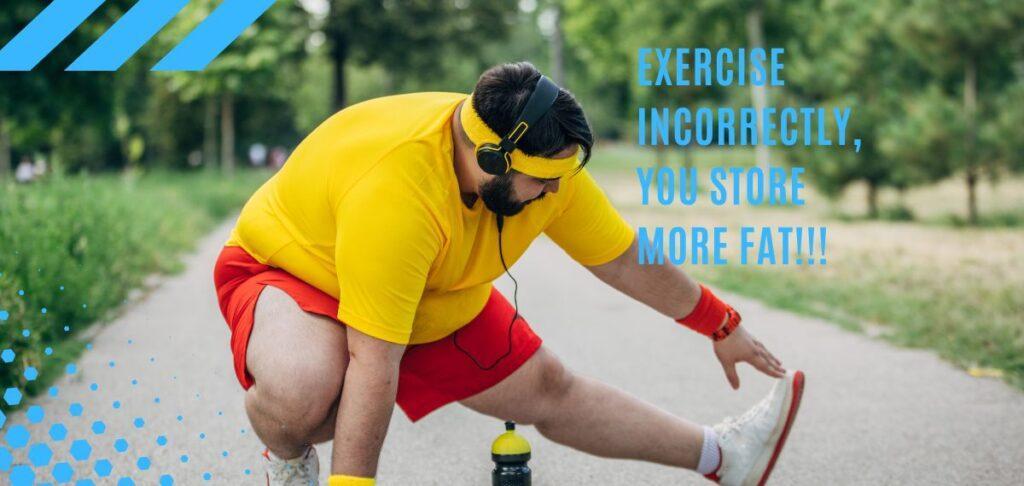Overtraining can potentially contribute to weight gain, especially if an individual is consuming excess calories without adequate rest and recovery. Overtraining symptoms include gaining weight while working out. What causes this condition?
- Understanding Overtraining Symptoms: More Than Just Fatigue
- 3 Signs You're Doing an Exercise Wrong - Overtraining Symptoms
- Overtraining symptoms - You're Not Getting the Results You Expect
- Overtraining Symptoms: Working Out And Gaining Weight Instead Of Losing
- What Can You Do to Fix These Problems?
- Why Do Men and Women Store Fat Differently?
- 🧬 Genetic & Ethnic Factors
- 🥗 Lifestyle & Diet Factors
- ❤️ Health Risks from Fat Distribution
- Source & Credits
When you engage in intense exercise and training, your body requires sufficient time to repair and build muscle tissue. Without adequate recovery time, your body can experience increased stress and inflammation, which can lead to weight gain, particularly in the form of water retention and increased fat storage.
In addition, overtraining can also increase levels of the stress hormone cortisol, which can stimulate fat storage and promote muscle breakdown. Overtraining can also negatively impact sleep quality, which can disrupt hormone levels and contribute to weight gain.
Understanding Overtraining Symptoms: More Than Just Fatigue
It’s important to note that weight gain due to overtraining is not typical and usually only happens in extreme cases. However, listening to your body and ensuring you get enough rest and recovery time to avoid any negative impacts of overtraining is essential.
Overtraining is exercising too much or training at a high intensity for too long. This can cause muscle soreness, fatigue, and even injury. If you experience these symptoms, you should take time off from exercise until they disappear.
Exercising is essential for our health; if you want to lose weight, you must exercise correctly. However, did you know that exercising improperly could cause you to gain extra pounds rather than lose them?
Common Overtraining Symptoms: More Than Just Tiredness
People often think they don’t have enough time to exercise because they have busy schedules or don’t enjoy it. However, if you wait for the perfect time to work out, you may never get started. Instead, you need to start exercising regularly now.
Skipping workouts can lead to serious health problems. You may miss out on an opportunity to build muscles, increase stamina, and improve overall fitness. In addition, you could injure yourself or cause further damage to your joints. Lastly, you won’t be able to develop the strength and endurance needed to perform everyday tasks.
3 Signs You’re Doing an Exercise Wrong – Overtraining Symptoms
If you want to improve your fitness level, there are three things you need to do. First, you need to make sure you’re getting enough sleep. Second, you need to eat well. And third, you need to work out consistently. But what about when you feel like you’re working out too much?
Or maybe you’re trying to figure out what exercises to do next. If you’re having trouble figuring out what exercises you’re supposed to be doing, here are three signs that you might be doing an exercise wrong.
-
Your form isn't great
The most obvious sign that you're doing an activity wrong is if you're holding yourself up improperly. For example, if you're doing squats, your knees shouldn't go above your toes. They should bend naturally. Also, if you're performing push-ups properly, your elbows should never touch your sides. Instead, your forearms should rest on the floor.
-
You're feeling pain
Another sign that you're doing something wrong is if you're experiencing pain while you're exercising. This doesn't necessarily mean that you're doing it wrong; it could simply mean that you need to adjust your technique. So if you notice that you're hurting during a particular movement, take note of what you did differently and try adjusting your approach.
-
You're losing momentum
A final sign that you're doing exercise wrong is if you're beginning to lose momentum. If you start slacking off or stopping altogether, chances are good that you're doing something that's causing you discomfort. In fact, sometimes people stop doing certain activities because they're afraid of injuring themselves. This isn't always the case, though. Sometimes you'll decide that you don't enjoy a specific activity anymore, or you find that you're no longer motivated to keep pushing yourself. If you experience one of these situations, don't worry—it happens to everyone.
Overtraining symptoms – You’re Not Getting the Results You Expect
How often do you hear people say they want to get into shape but don’t know where to start? If you’re looking to shed some pounds or tone up, you’ve come to the right place.
The human body has evolved to adapt to its environment over millions of years. Our bodies respond differently depending on whether we are working out or resting. For example, our metabolism slows down when we sleep, and we burn fewer calories. On the other hand, when we exercise, our metabolism speeds up, and we burn more calories.
If you exercise too much, you may gain weight because your body isn’t burning enough fat.
Exercise is good for us, but sometimes we go overboard. When you exercise too much, your body starts storing energy instead of using it. This leads to excess water retention, causing weight gain.
If you’ve been working out regularly for several months, chances are good that you’ve likely noticed some muscle size and strength progress. There’s no doubt that lifting weights is great for getting fit, but if you want to see real gains in muscle mass and strength, you’ll need to take things one step further.
Overtraining Symptoms: Working Out And Gaining Weight Instead Of Losing
The problem is that many people don’t realize (overtraining symptoms) how much work needs to go into building muscle. They assume that just because they’re doing the exercises correctly, they’ll automatically start seeing results. In reality, there’s a lot more to gaining muscle than simply doing the workouts.
What Can You Do to Fix These Problems?
If you want to fix your core strength, understanding what makes up a strong core is a start. A strong core helps stabilize your entire body during movement and allows you to move efficiently. If you don’t know how to build a strong core, here are some things you can try:
1. Perform pushups regularly. Pushups target your chest muscles and help improve your overall stability.
2. Use dumbbells to perform squats and lunges. Squats and lunges strengthen your lower body while improving balance and coordination.
3. Work on your core every day. Try doing planks, crunches, side planks, bridges, and reverse crunches.
4. Start slowly and progress slowly. Don’t rush into heavy lifting. Instead, start with lighter weights and focus on building endurance.
5. Find exercises that challenge your core. Core training includes everything from planks to kettlebells.
6. Get familiar with your equipment. If you don’t already have access to a gym or a home gym, consider investing in a set of dumbbells, a bench press bar, a medicine ball, and a yoga mat.
Why Do Men and Women Store Fat Differently?
Fat distribution differs notably between men and women due to various biological, hormonal, genetic, and lifestyle-related factors. Understanding these differences is essential for crafting personalized weight loss strategies, preventing overtraining symptoms, and maintaining metabolic health.
🔬 Biological & Hormonal Factors
1. Hormonal Influence
Estrogen in women encourages fat storage around the hips, thighs, and breasts—areas rich in subcutaneous fat. Testosterone in men promotes the accumulation of visceral fat in the abdominal area, which is more harmful due to its proximity to internal organs.
2. Metabolic Rate
Men tend to burn more calories at rest due to higher muscle mass. Women’s metabolism, however, can fluctuate with the menstrual cycle, sometimes leading to inconsistent fat-burning efficiency.
🧬 Genetic & Ethnic Factors
1. Body Shape Inheritance
Genetics largely dictate whether a person is more likely to be apple-shaped (more common in men) or pear-shaped (more common in women). These tendencies impact where fat is stored and how easily it's burned.
2. Ethnic Variation
Some ethnic groups are predisposed to store fat centrally. For example, South Asians often show greater abdominal fat accumulation and are at a higher risk of developing metabolic syndrome.
🥗 Lifestyle & Diet Factors
1. Diet and Emotional Eating
High-sugar and high-carb diets lead to central fat storage. Hormonal changes in women also increase emotional eating patterns, especially during PMS or menopause, affecting fat storage.
2. Exercise, Stress & Overtraining
While physical activity is vital for fat loss, excessive training without rest can lead to overtraining symptoms—including fatigue, sleep disturbances, and hormonal imbalances that promote fat retention instead of loss.
- Fatigue and burnout
- Slower metabolism due to muscle breakdown
- Increased cortisol levels contributing to belly fat
To avoid overtraining symptoms, both men and women must balance intense workouts with recovery and proper nutrition.
❤️ Health Risks from Fat Distribution
1. Cardiovascular Health
Visceral fat significantly increases the risk of heart disease and stroke. Women with a high waist-to-hip ratio are especially vulnerable post-menopause.
2. Metabolic Syndrome
Men are more prone to metabolic syndrome earlier in life, but women's risk increases dramatically after menopause due to a drop in estrogen levels and changes in fat storage patterns.
✅ Conclusion
Storage patterns in men and women are shaped by a combination of hormonal, genetic, and lifestyle factors. By recognizing these differences, individuals can create tailored health plans that include proper exercise, diet, and rest to prevent overtraining symptoms and improve long-term wellness.👉 Pro Tip: If you're experiencing burnout, fatigue, or plateauing in your fat loss goals, evaluate your routine for signs of overtraining symptoms. A short recovery phase can help reset hormones and metabolism!
Share this:
- Click to share on Facebook (Opens in new window) Facebook
- Click to share on Pinterest (Opens in new window) Pinterest
- Click to share on LinkedIn (Opens in new window) LinkedIn
- Click to share on X (Opens in new window) X
- Click to share on Tumblr (Opens in new window) Tumblr
- Click to share on Bluesky (Opens in new window) Bluesky


Ready to burn those calories and crush your fitness goals? Wait up! It’s important to strike a balance between pushing your limits and respecting your body
It’s so frustrating when hard work doesn’t show the expected results. Overtraining can impact weight loss. Perhaps consider adding more variety to your workouts and focusing on quality over quantity. Also, make sure you’re getting enough sleep and proper nutrition – they’re game-changers! You’ve got this!
I totally get where you’re coming from. I went through a phase of overtraining, and it seemed counterintuitive that I was gaining weight. Turns out, our bodies need that recovery time to shed fat and build muscle effectively. Maybe try easing up a bit, and the results might surprise you!
I’ve been exploring ways to maintain a healthy weight as I age, and understanding the link between burning fat and the aging process is eye-opening.
Feeling overly fatigued despite regular rest? Overtraining can sneak up on you! 🌟 Listen to your body—symptoms like persistent muscle soreness, lack of motivation, and disturbed sleep might be signs.
Wow, this really resonates! I’ve been so focused on pushing hard, but feeling constantly drained. The idea that overtraining could actually cause weight gain is a wake-up call. It really makes me think about how I approach my fitness routine.
Figures. Another reason why fitness is just a setup for disappointment. Work yourself to exhaustion, then get rewarded with weight gain? What’s even the point anymore.